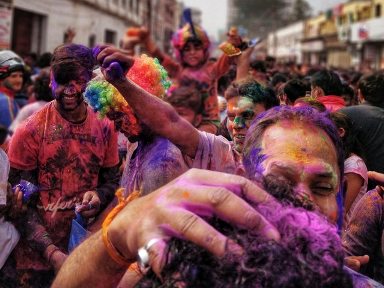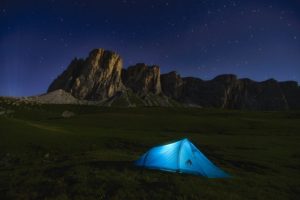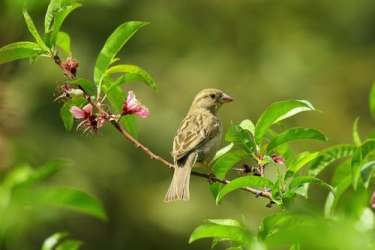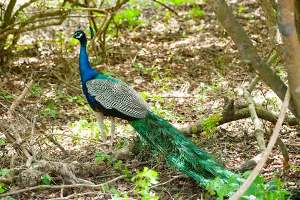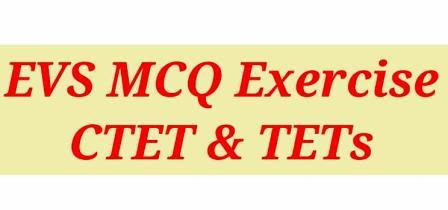
In this following section of EVS MCQ Exercise for CTET & TETs, 30 questions (MCQ) with 4 choices from Environmental Studies (EVS) are given. Choose the right answer for each question. Answer of these questions are available in the last of this post. Check how many of your answers are correct.
EVS MCQ Exercise
1- ‘Global Warming’ means
a) Increase in temperature of the Earth due to green house gases
b) high and low tide in the sea
c) emission of gases in atmosphere from dense forest
d) increase in temperature of Earth due to wind energy
2- Which of the following is largest ecosystem in the Earth?
a) Desert
b) Ocean
c) Forest
d) Agricultural land
3- There are three R’s to save our environment which are
a) reduce, recycle and reform
b) reuse, restructure and reform
c) reduce, recycle and reuse
d) reduce, recycle and restructure
4- Which of the following Sun’s rays is stopped by ozone layer?
a) Infrared rays
b) X-rays
c) Ultraviolet rays
d) None of these
5- Acid rain is chiefly due to atmospheric pollution by
a) SO2
b) H2S
c) HCl
d) N2
Famous Major Newspapers of the World
6- Which two gases make upto 99% of the atmosphere?
a) Ozone and oxygen
b) Oxygen and nitrogen
c) Carbondioxide and ozone
d) Argon and ozone
7- Ozone layer is found in Earth’s atmospheric layer:
a) Troposphere
b) Mesosphere
c) Stratosphere
d) Ionosphere
8- The abbreviation EVS stands for
a) Environmental Skills
b) Environmental Science
c) Environmental Source
d) Environmental Studies
9- The lowest layer of atmosphere is known as
a) troposphere
b) stratosphere
c) ionosphere
d) oxonosphere
10- Acid rain is caused due to increase in concentration of
a) SO2 and NO2
b) CO and N2
c) CO2 and N2
d) dust and O3
11- Who is responsible for the formation of humus?
a) Producer
b) Decomposer
c) Consumer
d) All of these
12- How much percentage of the Earth’s surface is covered with water?
a) 60%
b) 71%
c) 77%
d) 80%
13- The main objective of NCTE is
a) to open school
b) to maintain education level in schools
c) to encourage research in education
d) give grants to schools
14- ‘Van Mahotsav Diwas’ is celebrated in the country on
a) 2nd October
b) 1st July
c) 10th August
d) 1st December
15- When was Project Tiger launched?
a) 2011
b) 1970
c) 1973
d) 2007
Square Trick for Number ending with 5
16- Which book has been prepared by International Union for Conservation of Nature and Natural Resources (IUCN) concerning endangered species of plants and animals?
a) White Data Book
b) Red Data Book
c) Blue Data Book
d) None of the above
17- Environmental Impact Assessment (EIA) was formally established in USA in the year:
a) 1967
b) 1969
c) 1971
d) 1973
18- The first ‘World Environment Day’ was held in
a) 1972
b) 1974
c) 1984
d) 1992
19- Rio Earth Summit was held in which year?
a) 1972
b) 1977
c) 1992
d) 1998
20- When was the celebration of the ‘World Environment Day’ began to rotate around the globe?
a) 1977
b) 1982
c) 1988
d) 1972
Important Questions on Noun for CTET and TET
21- What was the theme of the first ‘World Environment Day’?
a) When people put the Environment First, Development will last
b) A Tree for Peace
c) Only One Earth
d) Only One Future for Our Children
22- ‘World Environment Day’ is celebrated on
a) 5th November
b) 5th January
c) 5th June
d) 5th September
23- Heuristic method is propounded by which educationist?
a) Herbert Spencer
b) Armstrong
c) Dewey
d) Freud
24- Which method is based on Heuristic method?
a) Analysis
b) Problem-solving
c) Investigation
d) All of these
25- Micro-teaching helps to develop which of the following teaching skills?
a) Team teaching
b) Lecturing skill
c) Questioning skill
d) Both (b) and (c)
Previous Year Questions on Learning Disabilities for TET
26- The total number of members of Parliament from Rajasthan is
a) 20
b) 25
c) 22
d) 24
27- Who presides over the meetings of the Rajya Sabha?
a) Vice-President
b) President
c) Prime Minister
d) Chief Justice of India
28- How many members of Rajya Sabha are nominated by the President
a) 12
b) 18
c) 20
d) 22
29- How many Lok Sabha seats are there in India?
a) 543
b) 545
c) 550
d) 555
30- How many Rajya Sabha seats are there in India?
a) 245
b) 250
c) 275
d) 230
Answers of above EVS MCQ Exercise for CTET & TETs
1(a), 2(b), 3(c), 4(c), 5(a), 6(b), 7(c), 8(d), 9(a), 10(a), 11(b), 12(b), 13(c), 14(b), 15(c), 16(b), 17(b), 18(b), 19(c), 20(c), 21(c), 22(c), 23(b), 24(b), 25(d), 26(b), 27(a), 28(a), 29(a), 30(a)
You may use ‘comment section’ below for your valuable comments/feedback.
